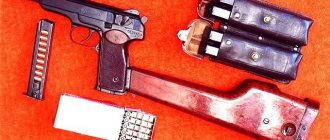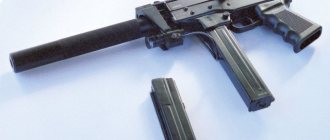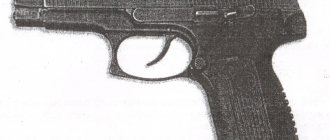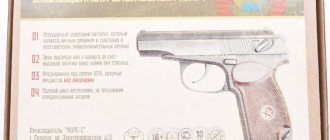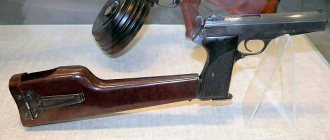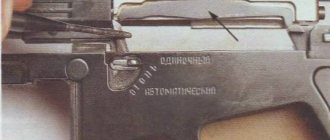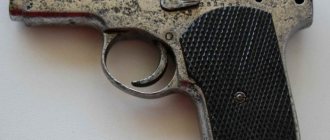Description
The Stechkin Automatic Pistol
(
APS
) is an automatic pistol developed in the late 1940s - early 1950s by designer I. Ya. Stechkin and adopted by the USSR Armed Forces in 1951, simultaneously with the Makarov pistol.
The APS is intended for arming officers directly involved in combat operations, as well as for soldiers and sergeants of some special units. The weapon could fire both single shots and bursts. Cooled APS-SKh (Automatic Pistol Stechkin) R-414 (No. 549, 1954)
Chilled APS-SKh (Automatic Pistol Stechkin) R-414 (No. 549, 1954)
Cooled APS-SKh (Automatic Pistol Stechkin) R-414 (No. 549, 1954)
Cooled APS-SKh (Automatic Pistol Stechkin) R-414 (No. 549, 1954)
Cooled APS-SKh (Automatic Pistol Stechkin) R-414 (No. 549, 1954)
Cooled APS-SKh (Automatic Pistol Stechkin) R-414 (No. 549, 1954)
Cooled APS-SKh (Automatic Pistol Stechkin) R-414 (No. 549, 1954)
Cooled APS-SKh (Automatic Pistol Stechkin) R-414 (No. 549, 1954)
The APS pistol was also intended for the crews of combat vehicles that were not entitled to a machine gun or carbine. At the same time, it was rightly believed that the PM pistol would not be sufficient for self-defense in the event of a collision with the enemy.
Cooled APS-SKh (Automatic Pistol Stechkin) R-414 (No. 549, 1954)
Cooled APS-SKh (Automatic Pistol Stechkin) R-414 (No. 549, 1954)
Cooled APS-SKh (Automatic Pistol Stechkin) R-414 (No. 549, 1954)
However, the use of the pistol in the army revealed a number of shortcomings - the inconvenience of wearing a massive holster-butt, the large dimensions of the weapon and the impracticality of automatic fire. The handle with a small angle of inclination takes some time to get used to and is not very suitable for “instinctive” shooting offhand. Most officers considered this pistol to be overly large and uncomfortable for everyday carry, especially in peacetime conditions. Along with the pistol, it was necessary to carry four loaded spare magazines (each with 20 rounds) in pouches, which further burdened the serviceman.
In 1958, the APS was discontinued, and in the 1960s, the bulk of army pistols ended up in warehouses (although it was in service with certain categories of military personnel, in particular grenade launchers (RPG-7) and machine gunners (PK), it was in service before the start of 1980s).
The APS, which has better shooting accuracy, less recoil, less barrel toss when firing and much greater firepower than the PM, continued to be used by the KGB of the USSR and military personnel of some specialties of the GRU Special Forces.
Due to the increase in crime rates in the second half of the 1980s and 1990s, the Ministry of Internal Affairs required a more powerful weapon than the Makarov pistol that was in service. Since before this “police” small-sized submachine guns had not been produced in the USSR, the Stechkin pistol turned out to be quite acceptable as a temporary solution to the problem. Subsequently, along with it, submachine guns chambered for the same 9×18 cartridge were adopted, however, the proven “Stechkin” still retains a certain popularity in our time.
The weapon is still used in the Russian army. Now they are armed with officers of infantry units and special forces security forces.
After the collapse of the USSR, the pistol was used in various local conflicts.
- Thus, during the fighting in Chechnya, pilots and snipers were armed with APS pistols as a personal weapon of self-defense
- is currently in service as a personal weapon for pilots of the Russian air group in Syria
Cooled SHP Stechkin pistol APS (APS SO, TOZ) 10x24
APS SO from Tula is a watered-down model of the Stechkin automatic combat pistol (APS).
The cooled SHP APS fires light-sound cartridges of 10x24 caliber. Blank cartridges are similar in appearance to real cartridges and consist of a cartridge case containing gunpowder devoid of a bullet; when fired, they emit a loud sound and emit a flame. Such cartridges can be purchased in special weapons stores or in the “blank cartridges” section of our store, and sometimes they come complete with the purchased SHP weapon model.
APS-SO has made a number of changes that do not allow the use of live cartridges:
- pins are installed in the barrel bore;
- the barrel and frame are welded together;
- the frame is weakened by a cut;
- The feed path has been changed to allow the use of cartridges with exclusively light and sound effects.
Features of APS-SO:
- authenticity - the appearance and mechanics of operation are similar to combat;
- quality and reliability - deactivation from the original decommissioned combat APS;
- the ability to conduct both semi-automatic and automatic fire;
- powerful and loud shot, due to the use of a light-sound cartridge of 10x24 mm caliber.
Purpose:
The cooled APS pistol is used to study the material part of weapons, is used in reconstructions, theatrical productions and filming, and is also valued by collectors and weapons lovers.
Equipment:
Each cooled APS SO pistol is supplied with: a magazine for 10 places, a wooden or bakelite holster - buttstock, documents (passport and certificate) and a box.
Depending on the configuration, the following may be added: an original pouch, additional magazines, blank cartridges, oils for cleaning and lubrication, etc.
Information about combat APS:
The Stechkin automatic pistol has the same caliber as the Makarov pistol (9 mm). But it surpasses it in firepower, sighting range and combat effectiveness - thanks to a more capacious magazine (20 rounds versus 8), a long barrel (140 mm versus 93.5 mm), and the ability to fire in bursts.
"Stechkin", like "Makarov", was developed in 1948, and in 1951 it was adopted by the Soviet Army. The author of the design was Tula designer Igor Stechkin. At the time of production of the first prototype of the pistol, he was only 26 years old. The APS became the first domestic submachine gun for close combat. It did not last long (less than a decade) in mass serial production at the Vyatsko-Polyansky Machine-Building Plant. However, it was the Stechkin pistol that became the founder of a whole class of weapons - small-sized submachine guns for special forces.
Unlike the PM - a police “peacetime weapon” and senior army officers, the APS was originally planned for use in combat conditions. It was intended for line army officers; grenade launchers, flamethrowers and machine gunners; crew members of tanks, combat vehicles, aircraft. Everywhere where a machine gun would take up too much space, and a regular pistol would be of little use due to the meager ammunition and short sighting range.
The main feature of the Stechkin pistol is its double-row magazine, in which the cartridges are arranged in a checkerboard pattern. Due to this, the APS handle is thicker than that of the PM, which takes some getting used to. The barrel has an internal bore with 4 rifling, curled from left to right. The trigger mechanism is double action. It allows you to safely hold a loaded pistol with a cartridge in the chamber and the hammer on the safety cock. The shot can be fired instantly, by self-cocking.
Characteristics of the combat APS: Weight (curb): 1.22 kg + holster-butt O.56 kg; Cartridge: 9x18mm (PM); Combat rate of fire: 4O rounds per minute with single shots, 9O with bursts; Sighting range: 2OO m.
In the modern Russian army, "Stechkins" are a rarity. Since the mid-70s, a shortened Kalashnikov assault rifle has been used as a compact weapon for tankers and other categories of military personnel to whom the APS was addressed. Special units of the Ministry of Internal Affairs, FSB, FSIN still use the Stechkin pistol, along with modern compact submachine guns of the Kedr type.
Why our store?
Our store is popular among a large number of customers who appreciate the positive aspects of working with us:
- Discount system. It makes it possible to prevent significant costs for regular customers when purchasing cold weapons.
- Courier service. The purchased goods are delivered to the place designated by the buyer quickly and without incident.
- Working with clients. Consultants do not intentionally try to persuade people to buy expensive goods. Advice on selection is given taking into account the wishes of the client.
We actively cooperate with state educational and sports centers DOSAAF, military-patriotic clubs, schools and many other commercial and non-profit organizations. For regular customers, we are always ready to offer individual prices and terms of cooperation.
To buy a cooled Stechkin APS pistol in Moscow at a low price or with delivery throughout Russia, make an application on our website or just call. Our manager will advise you in detail on any product, delivery conditions and discounts. Product quality. The product is carefully checked, which allows us to offer customers high-quality and working samples.
Advantages of APS
Compared to the Makarov pistol, the APS provided significantly greater firepower and combat effectiveness due to its larger magazine capacity and longer barrel. For accurate shooting, the pistol was equipped with a holster-butt attached to the handle. The APS could fire in two modes: single shots and bursts. Thanks to the presence of a rate of fire retarder, the pistol remained quite controllable. The sound of the shot was quieter than that of the PM.
The weapon has high operational reliability, tested in difficult operating conditions, and subsequently in combat. The pistol has high shooting accuracy, despite the use of a cartridge with low ballistic qualities and a small angle of inclination of the handle. One of the main advantages is low recoil and very little barrel bounce when firing. This quality, combined with high (for such a weapon) accuracy, allows for high-speed shooting with single shots with a large accuracy of hits. This advantage is especially important for close combat. At the same time, the consumption of cartridges is also controlled. Thanks to the simplicity of the design, the APS is easy to maintain. This weapon has a significant safety margin: About 40,000 shots without cracks on the bolt casing or other serious damage.
Design and construction
The story about “Stechkin” would be incomplete without touching on its very concept. Even at the beginning of the twentieth century, the idea of so-called carbine pistols was very popular. There are many well-known examples - both the Luger P-08 artillery model and the K-96 Mauser, which, unlike the Luger, could fire in bursts. These pistols had several similar features: they had an increased magazine capacity, the barrel was heavy and elongated, and the design included a holster-butt for the convenience of the shooter.
APS scheme
Source: pinterest.ru
In the post-war period, in the late 40s, this concept was still popular. The submachine gun was still heavy and more cumbersome than the carbine pistol. A fast-firing and powerful pistol chambered for the new 9x18 PM cartridge was required. The Soviet Army came up with this task. The pistol was to be used by all categories of military personnel who, according to the state, were not entitled to a Kalashnikov assault rifle or an SKS carbine for self-defense in the event of a clash. Moreover, the military rightly judged that the PM would not be enough for this, which means that a pistol of a special design is required.
The task to develop a new weapon was given to the young and talented Tula gunsmith Igor Yakovlevich Stechkin. Today we will not dwell in detail on his biography, we will only say that it deserves a separate detailed story. One way or another, the pistol, developed since 1948, entered service in 1951, for which Stechkin received the Stalin Prize.
The APS was a well-tested barrel in factory and military tests. Modified several times during testing, it was not “raw” and came to the troops as a perfectly working pistol. Suffice it to say that the Stechkin’s competitors were the Sudaev submachine gun, the PPS and the Astra Mauser. In no way inferior to the PPS, the Stechkin left the Mauser far behind.
APS with attached butt-holster
Source: pinterest.ru
Its design was somewhat reminiscent of an enlarged PM, but not without nuances. The unique double-row magazine with a pair of cartridge outlets required good fitting of the parts. The disassembly scheme resembles Peam's with pulling the trigger guard down. Automation scheme - free movement of the shutter using recoil. At the top there is a fire switch that changes single and automatic modes; there is also a rate of fire retarder for less ammunition consumption. Outwardly it turned out to be a very aesthetic, albeit oversized, pistol, which Stechkin himself really liked. APS is somewhat reminiscent of the legendary Browning High power.
Disadvantages and reasons for discontinuation
Despite these advantages, the APS, especially in combination with a standard holster-butt, was too bulky and heavy to be constantly worn by a staff officer, and for an officer directly involved in combat operations, it was not a powerful enough weapon.
Disadvantages are also associated with the chosen cartridge: the ballistic characteristics of the 9x18 mm cartridge cannot provide a high initial bullet velocity and, accordingly, a good trajectory flatness. However, a short, about 100 meters, effective firing range is a common drawback of any weapon chambered for this type of cartridge (9*18 PM, 9*17, 9x19 Parabellum or .38 ACP, 9mm Ultra).
In addition, the penetration effect of the 9 PM ammunition is unsatisfactory, and weapons chambered for this cartridge are in principle ineffective against targets wearing body armor.
And therefore, in the mid-1970s, the “Modern” competition was launched in the USSR, the task of which was to develop and adopt a small-sized assault rifle chambered for a standard 5.45x39 mm cartridge, intended to replace the APS in the Soviet Army. The AKS-74U assault rifle was declared the winner.
Further development of the APS pistol was implemented in the 1990s, in later models of the Stechkin design.
The cooled Stechkin APS R-414 is a pistol that was previously used for combat. All characteristics of the pistol correspond to their combat counterparts. Instead of the original 9x18, the model uses 10x24 caliber blank cartridges. The magazine of the presented model has a capacity of 12 rounds. A distinctive feature of this SHP model R-414 from the Izhevsk plant is the ability to conduct both automatic and semi-automatic fire.
